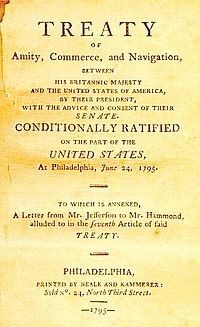Jay Treaty facts for kids
| Treaty of Amity, Commerce, and Navigation, Between His Britannic Majesty and The United States of America | |
|---|---|

First page of the Jay Treaty
|
|
| Context | To relieve post-war tension between Britain and the United States |
| Signed | November 19, 1794 |
| Location | London |
| Effective | February 29, 1796 |
| Negotiators | |
| Signatories |
|
The Treaty of Amity, Commerce, and Navigation, Between His Britannic Majesty and the United States of America, commonly known as the Jay Treaty, and also as Jay's Treaty, was a 1795 treaty between the United States and Great Britain that averted war, resolved issues remaining since the Treaty of Paris of 1783 (which ended the American Revolutionary War), and made way for ten years of peaceful trade between the United States and Britain in the midst of the French Revolutionary Wars, which began in 1792.
The Treaty was designed by Alexander Hamilton and supported by President George Washington. It angered France and bitterly divided Americans. It led to the formation of two opposing parties in every state, the pro-Treaty Federalists and the anti-Treaty Democratic Republicans. The Treaty was negotiated by John Jay and gained many of the primary American goals.
Treaty terms
Both sides achieved many objectives. Several issues were discussed, which were resolved mostly in favor of the U.S. Britain paid $11,650,000 for damages to American shipping and received £600,000 for unpaid pre-1775 debts.
The British agreed to vacate its forts in United States territory—six in the Great Lakes region and two at the north end of Lake Champlain—by June 1796; which was done.
American Indian rights
Article III of the Jay Treaty declared the right of Indians, American citizens, and Canadian subjects to trade and travel between the United States and Canada, which was then a territory of Great Britain. As a result of the Jay Treaty, "Native Indians born in Canada are therefore entitled to enter the United States for the purpose of employment, study, retirement, investing, and/or immigration". Article III of the Jay Treaty is the basis of most Indian claims.
Images for kids
-
Thomas Jefferson was harshly critical of the treaty.
See also
 In Spanish: Tratado de Jay para niños
In Spanish: Tratado de Jay para niños



